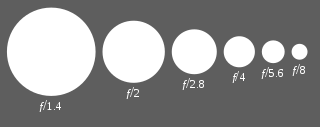
An f-number is a measure of the light-gathering ability of an optical system such as a camera lens. It is calculated by dividing the system's focal length by the diameter of the entrance pupil ("clear aperture").[1][2][3] The f-number is also known as the focal ratio, f-ratio, or f-stop, and it is key in determining the depth of field, diffraction, and exposure of a photograph.[4] The f-number is dimensionless and is usually expressed using a lower-case hooked f with the format f/N, where N is the f-number.
The f-number is also known as the inverse relative aperture, because it is the inverse of the relative aperture, defined as the aperture diameter divided by focal length.[5] The relative aperture indicates how much light can pass through the lens at a given focal length. A lower f-number means a larger relative aperture and more light entering the system, while a higher f-number means a smaller relative aperture and less light entering the system. The f-number is related to the numerical aperture (NA) of the system, which measures the range of angles over which light can enter or exit the system. The numerical aperture takes into account the refractive index of the medium in which the system is working, while the f-number does not.
- ^ Smith, Warren Modern Optical Engineering, 4th Ed., 2007 McGraw-Hill Professional, p. 183.
- ^ Hecht, Eugene (1987). Optics (2nd ed.). Addison Wesley. p. 152. ISBN 0-201-11609-X.
- ^ Greivenkamp, John E. (2004). Field Guide to Geometrical Optics. SPIE Field Guides vol. FG01. Bellingham, Wash: SPIE. p. 29. ISBN 9780819452948. OCLC 53896720.
- ^ Smith, Warren Modern Lens Design 2005 McGraw-Hill.
- ^ ISO, Photography—Apertures and related properties pertaining to photographic lenses—Designations and measurements, ISO 517:2008